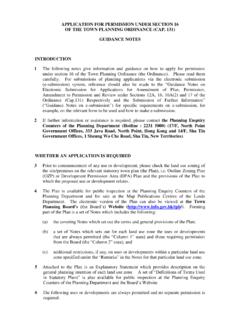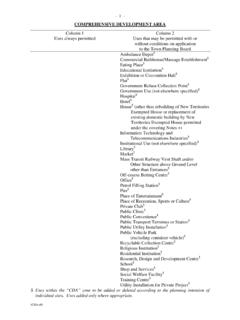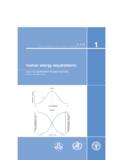Transcription of Review of the Role and Functions of Public Sector …
1 Review of the Role and Functions of Public Sector advisory and statutory bodies consultation paper Home Affairs Bureau April 2003 Page 2 Review of the Role and Functions of Public Sector advisory and statutory bodies Introduction The Government relies on a wide range of advisory and statutory bodies to provide advice on its policies and to deliver services. In order to enhance the existing system of Public Sector advisory and statutory bodies , the Home Affairs Bureau is conducting a Review of the role and Functions of these bodies .
2 The purpose of this paper is to consult the Public on the approach to the Review and the proposed guiding principles for reviewing advisory and statutory bodies . Background 2. In the course of the discussion of the accountability system in the Legislative Council, the Government indicated that it would Review the role and Functions of advisory and statutory bodies after the implementation of the accountability system and would revert to the Legislative Council on the findings of the Review .
3 3. At the swearing-in ceremony on 1 July 2002, the Chief Executive said in his speech that : "We will also Review and revise the structure covering over 400 advisory boards and committees, so that the organizational arrangements will enable us to consolidate the views and contribution of different sectors including the political, business, academic and grassroots sectors, amongst others." 4. There is a need to Review advisory and statutory bodies in the Public Sector in order to enhance their openness, effectiveness, representativeness and transparency.
4 Page 3 Policy 5. The main elements of Government's policy on advisory and statutory bodies are : (a) a new advisory or statutory body should only be set up if there is a demonstrated need for it; (b) advisory and statutory bodies should not determine government policies; responsibility for the policies of the day rests with principal officials; (c) an advisory or statutory body should be accountable to the Chief Executive or a principal official for the advice they give and/or for the way they carry out their Functions ; (d) the best people for the job should be appointed to an advisory or statutory body; (e) an advisory or statutory body should be open and transparent; (f) an advisory or statutory body should be representative of the different interests and sections of the community.
5 (g) when making appointments to advisory and statutory bodies , there should be no discrimination on the grounds of gender, age, race, disability, religion, marital status, sexual orientation or social background; (h) a statutory body should only be set up if it is the most appropriate and cost-effective means of carrying out its given function; and (i) an advisory or statutory body which is no longer needed should be wound up so as to keep the number of advisory and statutory bodies to a minimum.
6 Page 4 Classification 6. Boards and committees in the Public Sector can be classified into statutory and non- statutory bodies . statutory bodies are those that are set up by enabling legislation. They can either be advisory or executive. Non- statutory bodies are those that are set up administratively. They are mainly advisory bodies . 7. advisory and statutory bodies may also be classified by function as follows: (a) advisory committees; (b) non-departmental Public bodies ; (c) regulatory boards; (d) appeal boards; (e) trusts; (f) Public corporations; and (g) miscellaneous boards and committees.
7 8. advisory bodies are boards and committees set up to provide ongoing information, professional expertise in particular areas or subjects, and/or to advise on the development of policies or the delivery of services. Examples include the Commission on Youth and the Culture and Heritage Commission. 9. Non-departmental Public bodies are non-commercial organizations set up to deliver services to the Public at arm's length from the Government. They are not government departments or agencies, but they play a role in the processes of government.
8 Examples include the Hospital Authority and the Hong Kong Trade Development Council. 10. Regulatory boards can be divided into three types, namely registration boards, licensing boards and supervisory boards. A registration board regulates a profession or trade by way of registering entrants to the profession or trade. For example, the Land Surveyors Registration Committee regulates the registration of land surveyors. A Page 5 licensing board regulates the licensing of premises or equipment for a specific purpose or function.
9 For example, the Liquor Licensing Board issues liquor licences to bars, restaurants and other premises. A supervisory board supervises a specific activity or range of activities. For example, the Electoral Affairs Commission supervises and monitors Public elections in Hong Kong. 11. Appeal boards usually perform a semi-judicial function by adjudicating on appeals. Examples include the Hong Kong War Memorial Pensions Appeal Board and the Licensing Appeals Board.
10 12. Trusts are bodies set up to hold and control property for the benefit of named beneficiaries or for stated purposes. Examples include Board of Trustees of the Sir Edward Youde Memorial Fund and the Li Po Chun Charitable Trust Fund Committee. 13. Public corporations are commercial entities set up by law to provide goods or services. They are usually created by transferring the assets of a government department into a corporate structure. For example, the Kowloon-Canton Railway Corporation was established in this way.
















